Engineering, Durability, and Sustainability Properties Analysis of High-Volume, PCC Ash-Based Concrete
Abstract
1. Introduction
2. Methods and Materials
2.1. Materials
2.2. Experimental Procedures
2.3. Test Methods
- (i)
- Goal and scope definition: The environmental impacts of OPC and PCC, generated from the concrete manufacturing process, are analyzed using all the materials of concrete. The functional unit is defined as OPC, PCC ash, and water in a concrete mix with a 1 m3 size [42,43]. In the LCA of OPC and PCC considering their type, the W/B and replacement ratios are calculated to assess the environmental-impact value [42,43,44].
- (ii)
- Life cycle inventory analysis: The environmental-impact substance from OPC and PCC can be determined through life cycle inventory analysis. The input and output LCA to produce OPC, PCC ash and water are calculated using the life cycle inventory database (LCI DB) in South Korea [42,43,44,45]. For example, according to Korea National LCI DB, the PCC ash (kg-eq) is calculated from the pre-production stage, transport stage, and production stage. The consumption of energy, and water is also considered at these stage [45].
- (iii)
- LCIA: This process converts the environmental-impact substances from LCIA into the environmental impacts. The LCIA process includes (i) classification, (ii) characterization, (iii) normalization, and (iv) weighting. While classification and characterization are mandatory for calculating the environmental impact, normalization and weighting are optional. Thus, in this study, the characterized environmental impact was calculated through classification and characterization using Equation (1).where CIi is the characterized impact of the category (l). CIi,j is the characterized impact of the list item (j) in the category (i) in the one-unit function, Loadj is the environmental load of the list item (j), and eqvi,j is the characterization coefficient value of list item (j) in the category (i).
- (iv)
- This study is based on the “environmental labeling type III” standard, the characterized environmental impacts were categorized under six headings: (i) GWP; (ii) ODP; (iii) AP; (iv) EP; (v) POCP; and (vi) ADP [42,43]. As shown in Table 5, the characterized environmental impacts index is calculated and presented based on the LCI DB as kilogram equivalent(kg-eq) [42,45].
3. Experimental Results and Discussion
3.1. Raw Material Properties Analysis
3.2. Engineering Properties Analysis
3.3. Durability Properties Analysis
3.4. Sustainability Properties Analysis
4. Conclusions
- (1)
- The overall compressive strength decreased as the PCC ash replacement ratio increased in hardened concrete, and the compressive strength at 56 days showed a tendency to decrease rapidly in the range with a replacement ratio of 40% or higher. Therefore, in order to secure the target compressive strength (fck = 24 MPa), which was established in this study at 28 days, the replacement ratio of PCC ash should be maintained at 38.9% or less.
- (2)
- The durability review results showed that as the replacement ratio of PCC ash increased, the carbonation depth and relative dynamic elastic modulus increased. However, the chloride penetration depth showed a tendency to decrease. Nevertheless, the weight loss ratio was found to be similar. In addition, it was confirmed that the optimal PCC replacement ratio which satisfies four durability parameters and ensures the target compressive strength (fck = 24 MPa) in the case of the mix proportion conditions set in this study ranges from 20.0% to 38.9%.
- (3)
- The sustainability assessment revealed that as the replacement ratio of PCC ash increased, the GWP and ODP tended to decrease by 17.26 kg CO2 eq/m3 and 3.0 × 10−6 kg CFC-11 eq/m3, respectively. In addition, the AP and EP decreased by 0.086 kg SO2 eq/m3 and 0.004 kg PO43− eq/m3, respectively. Meanwhile, the POCP showed a decrease of 0.025 kg C2H4 eq/m3, and ADP a decrease 0.122 kg Sb eq/m3, respectively.
- (4)
- PCC ash was found to have less environmental impact than OPC in terms of GWP, AP, EP, POCP and ADP. This study has proven that the replacement of PCC ash instead of OPC under the same concrete mix proportions is effective at reducing environmental impacts.
- (5)
- It is expected that the engineering properties and durability analysis data of concrete incorporating PCC ash as well as the sustainability assessment results will help to provide a guide to the optimum mix proportion when high-volume, PCC-based concrete is applied to local construction sites in the future, and may serve as basic data in the development of concrete and binders that can minimize environmental impacts.
- (6)
- The limitation of this study was that it did not find the cause or reasons why the resistance performance was secured to an equal or higher level when the substitution rate of PCC ash was increased under freezing and thawing in the presence of deicer salts.
- (7)
- Future studies need to elaborate on the cause of the properties of the relative dynamic elastic modulus and weight reducing ratio. In addition, it is required to examine the change in durability characteristics when temperature changes, seawater immersion conditions, and silica fume are added.
Author Contributions
Funding
Conflicts of Interest
References
- Bulatović, V.; Melešev, M.; Radeka, M.; Radonjanin, V.; Luki´c, I. Evaluation of sulfate resistance of concrete with recycled and natural aggregates. Constr. Build. Mater 2017, 152, 614–631. [Google Scholar] [CrossRef]
- Flower, D.; Sanjayan, J.; Baweja, D. Environmental impacts of concrete production and construction. In Proceedings of the Concrete Institute of Australia Biennial Conference, Melbourne, Australia, 17–19 October 2005. [Google Scholar]
- Wang, L.; Yang, H.Q.; Dong, Y.; Chen, E.; Tang, S.W. Environmental evaluation, hydration, pore structure, volume deformation and abrasion resistance of low heat Portland (LHP) cement-based materials. J. Clean. Prod. 2018, 203, 540–558. [Google Scholar] [CrossRef]
- Xu, X.N.; Yang, Y.L.; Xiao, C.; Zhang, X.M. Energy balance and global warming potential of corn straw-based bioethanol in China from a life cycle perspective. Int. J. Green Energy 2018, 15, 296–304. [Google Scholar] [CrossRef]
- Pellecchia, M.; Negri, I. Particulate matter collection by honey bees (Apis mellifera, L.) near to a cement factory in Italy. PeerJ 2018, 6, e5322. [Google Scholar] [CrossRef] [PubMed]
- Liu, H.; Luo, G.; Wang, L.; Gong, Y. Strength Time–Varying and Freeze–Thaw Durability of Sustainable Pervious Concrete Pavement Material Containing Waste Fly Ash. Sustainability 2019, 11, 176. [Google Scholar] [CrossRef]
- Han, S.H.; Kim, J.K.; Park, Y.D. Prediction of compressive strength of fly ash concrete by new apparent activation energy function. Cem. Concr. Res. 2003, 33, 965–971. [Google Scholar] [CrossRef]
- Lee, J.; Lee, T. Influences of Chemical Composition and Fineness on the Development of Concrete Strength by Curing Conditions. Materials 2019, 12, 4061. [Google Scholar] [CrossRef]
- Wang, C.Y.; Olsson, G.; Liu, Y. Coal-fired power industry water-energy-emission nexus: A multi-objective optimization. J. Clean. Prod. 2018, 203, 367–375. [Google Scholar] [CrossRef]
- ASTM. Specification for Coal Fly Ash and Raw or Calcined Natural Pozzolan for Use in Concrete; American Society for Testing Materials: West Conshohocken, PA, USA, 2017. [Google Scholar] [CrossRef]
- Anthony, E.J.; Granatstein, D.L. Sulfation phenomena in fluidized bed combustion systems. Prog. Energy Combust. Sci. 2001, 27, 215–236. [Google Scholar] [CrossRef]
- Koornneef, J.; Junginger, M.; Faaij, A. Development of fluidized bed combustion—An overview of trends, performance and cost. Prog. Energy Combust. Sci. 2007, 33, 19–55. [Google Scholar] [CrossRef]
- Armesto, L.; Merino, J.L. Characterization of some coal combustion solid residues. Fuel 1999, 78, 613–618. [Google Scholar] [CrossRef]
- Lin, W.T.; Weng, T.L.; Cheng, A.; Chao, S.J.; Hsu, H.M. Properties of controlled low strength material with circulating fluidized bed combustion ash and recycled aggregates. Materials 2018, 11, 715. [Google Scholar] [CrossRef] [PubMed]
- Lee, J.; Kim, G.; Kim, Y.; Mun, K.; Nam, J. Engineering properties and optimal conditions of cementless grouting materials. Materials 2019, 12, 3059. [Google Scholar] [CrossRef] [PubMed]
- Lee, J.; Lee, T. Effects of high CaO fly ash and sulfate activator as a finer binder for cementless grouting material. Materials 2019, 12, 3664. [Google Scholar] [CrossRef] [PubMed]
- Van Nguyen, C.; Lambert, P.; Hung Tran, Q. Effect of Vietnamese fly ash on selected physical properties, durability and probability of corrosion of steel in concrete. Materials 2019, 12, 593. [Google Scholar] [CrossRef] [PubMed]
- Malhotra, V.M.; Zhang, M.H.; Read, P.H.; Ryell, J. Long-term mechanical properties and durability characteristics of high-strength/high-performance concrete incorporating supplementary cementing materials under outdoor exposure conditions. ACI Mater. J. 2000, 97, 518–525. [Google Scholar] [CrossRef]
- Barbhuiya, S.; Kumala, D. Behaviour of a sustainable concrete in acidic environment. Sustainability 2017, 9, 1556. [Google Scholar] [CrossRef]
- Kurda, R.; Silvestre, J.D.; Brito, J. Life cycle assessment of concrete made with high volume of recycled concrete aggregates and fly ash. Resour. Conserv. Recyc. 2018, 139, 407–417. [Google Scholar] [CrossRef]
- Zhu, Y.; Zhang, Z.C.; Yang, Y.G.; Yao, Y. Measurement and correlation of ductility and compressive strength for engineered cementitious composites (ECC) produced by binary and ternary systems of binder materials: Fly ash, slag, silica fume and cement. Constr. Build. Mater. 2014, 68, 192–198. [Google Scholar] [CrossRef]
- Ma, H.X.; Yu, H.F.; Li, C.; Tan, Y.S.; Cao, W.T.; Da, B. Freeze–thaw damage to high–performance concrete with synthetic fibre and fly ash due to ethylene glycol deicer. Constr. Build. Mater. 2018, 187, 197–204. [Google Scholar] [CrossRef]
- Mohammed, B.S.; Adamu, M.; Liew, M.S. Evaluating the effect of crumb rubber and nano silica on the properties of high volume fly ash roller compacted concrete pavement using non-destructive techniques. Case Stud. Constr. Mater. 2018, 8, 380–391. [Google Scholar] [CrossRef]
- Kumar, B.; Sinha, S.; Chakravarty, H. Study of Effect of Nano-Silica on Strength and Durability Characteristics of High Volume Fly Ash Concrete for Pavement Construction. Civil Eng. J. 2019, 5, 1341–1352. [Google Scholar] [CrossRef]
- Adamu, M.; Mohammed, B.S.; Shafiq, N. Nano silica modified roller compacted rubbercrete–An overview. In Engineering Challenges for Sustainable Future. ROUTLEDGE Assoc. GSE Res. 2016, 483, 483–487. [Google Scholar] [CrossRef]
- Chu, T.X.H.; Zheng, J.; Chen, D.; Nguyen, T.T.H.; Elbashiry, E.; Tang, V.T. Utilization of Industrial Waste in Cement in a Marine Environment with a Tropical Climate. J. Mar. Sci. Eng. 2019, 7, 245. [Google Scholar] [CrossRef]
- Naibaho, A. The effectiveness of fly ash as a substitute of cement for marine concrete. Civil Eng. J. 2018, 4, 702. [Google Scholar] [CrossRef]
- Thomas, M.D.A. Optimizing the Use of Fly Ash in Concrete; Portland Cement Association: Skokie, IL, USA, 2007; Volume 5420. [Google Scholar]
- Korean Standards Association. Portland Cement. KS L 5201; Korean Standards Association: Seoul, Korean, 2006. [Google Scholar]
- Korean Standard Association. Fly Ash. KS L 5405; Korean Standard Association: Seoul, Korean, 2016. [Google Scholar]
- ASTM. Standard test methods for fineness of hydraulic cement by air-permeability apparatus. In Annu. Book ASTM; ASTM International: West Conshohocken, PA, USA, 2007. [Google Scholar] [CrossRef]
- ASTM. Standard guide for examination of hardened concrete using scanning electron microscopy. Concr. Aggregat 2010, 4, 2. [Google Scholar] [CrossRef]
- ASTM. Standard Test Methods for Chemical Analysis of Hydraulic Cement. Am. Soc. Test. Mater. 2018. [Google Scholar] [CrossRef]
- ASTM. Standard Test Method for Sieve Analysis of Fine and Coarse Aggregates. Am. Soc. Test. Mater. 2019. [Google Scholar] [CrossRef]
- ASTM. Standard Test Method for Air Content of Freshly Mixed Concrete by the Pressure Method. Am. Soc. Test. Mater. 2017. [Google Scholar] [CrossRef]
- ASTM. Standard Test Method for Compressive Strength of Concrete Cylinders Cast in Place in Cylindrical Molds. Am. Soc. Test. Mater. 2015. [Google Scholar] [CrossRef]
- ASTM. Standard Test Method for Compressive Strength of Cylindrical Concrete Specimens. Am. Soc. Test. Mater. 2018. [Google Scholar] [CrossRef]
- Korean Standards Association. Standard Test Method for Accelerated Carbonation of Concrete [KS F 2584]; Korean Standards Association: Seoul, Korea, 2015. [Google Scholar]
- NT BUILD 492, ‘Concrete, mortar and cement-based repair materials: Chloride migration coefficient from non-steady-state migration experiments’. Nord. Method 1999, 1–8.
- ASTM. Standard Test Method for Resistance of Concrete to Rapid Freezing and Thawing. Am. Soc. Test. Mater. 2015. [Google Scholar] [CrossRef]
- ISO. Environmental Management: Life Cycle Assessment; Requirements and Guidelines; International Organization for Standardization: Geneva, Switzerland, 2006. [Google Scholar] [CrossRef]
- Jeong, J.; Hong, T.; Kim, J.; Chae, M.; Ji, C. Multi-criteria analysis of a self-consumption strategy for building sectors focused on ground source heat pump systems. J. Clean. Prod. 2018, 186, 68–80. [Google Scholar] [CrossRef]
- Kim, J.; Hong, T.; Jeong, J.; Koo, C.; Jeong, K. An optimization model for selecting the optimal green systems by considering the thermal comfort and energy consumption. Appl. Energy 2016, 169, 682–695. [Google Scholar] [CrossRef]
- Rahla, K.M.; Mateus, R.; Bragança, L. Comparative sustainability assessment of binary blended concretes using Supplementary Cementitious Materials (SCMs) and Ordinary Portland Cement (OPC). J. Clean. Prod. 2019, 220, 445–459. [Google Scholar] [CrossRef]
- Korea Environmental Industry and Technology Institute (KEITI). LCI DB. Available online: http://www.epd.or.kr/ (accessed on 21 November 2019).
- Fan, C.; Miller, S.A. Reducing greenhouse gas emissions for prescribed concrete compressive strength. Constr. Build. Mater. 2018, 167, 918–928. [Google Scholar] [CrossRef]
- Kim, T.; Tae, S.; Chae, C. Analysis of environmental impact for concrete using LCA by varying the recycling components, the compressive strength, and the admixture material mixing. Sustainability 2016, 8, 389. [Google Scholar] [CrossRef]
- Damineli, B.L.; Kemeid, F.M.; Aguiar, P.S.; John, V.M. Measuring the eco-efficiency of cement use. Cem. Concr. Compos. 2010, 32, 555–562. [Google Scholar] [CrossRef]
- Yang, K.H.; Jung, Y.B.; Cho, M.S.; Tae, S.H. Effect of supplementary cementitious materials on the reduction of CO2 emissions from concrete. J. Clean. Prod. 2015, 103, 774–783. [Google Scholar] [CrossRef]
- Yang, K.H.; Song, J.K.; Song, K.I. Assessment of CO2 reduction of alkali-activated concrete. J. Clean. Prod. 2013, 39, 265–272. [Google Scholar] [CrossRef]
- Thomas, M.D.A.; Matthews, J.D. Carbonation of fly ash concrete. Mag. Concr. Res. 1992, 44, 217–228. [Google Scholar] [CrossRef]
- Thomas, M.D.A.; Wilson, M.L. Supplementary Cementing Materials for Use in Concrete; PCA: Skokie, IL, USA, 2002. [Google Scholar]
- Thomas, M.D.A. The Effect of Curing on the Hydration and Pore Structure of Hardened Cement Paste Containing Pulverized-Fuel Ash. Adv. Cem. Res. 1989, 2, 181–188. [Google Scholar] [CrossRef]
- Bilodeau, A.; Carette, G.G.; Malhotra, V.M. Influence of curing and drying on salt scaling resistance of fly ash concrete. Spec. Publ. 1991, 126, 201–228. [Google Scholar]
- Naik, T.R.; Ramme, B.W.; Tews, J.H. Pavement Construction with High-Volume Class C and Class F Fly Ash Concrete. ACI Mater. J. 1995, 92, 200–210. [Google Scholar] [CrossRef]
- Yerramala, A.; Ganesh Babu, K. Transport properties of high volume fly ash roller compacted concrete. Cem. Concr. Compos. 2011, 33, 1057–1062. [Google Scholar] [CrossRef]
- Thomas, M.D.A. Laboratory and Field Studies of Salt Scaling in Fly Ash Concrete; Setzer, M.J., Auberg, R., Eds.; Frost Resistance of Concrete: Essen, Germany, 1997. [Google Scholar]
- Lankard, D.R. Slurry infiltrated fiber concrete (SIFCON): Properties and applications. MRS Online Proc. Libr. Arch. 1984, 42. [Google Scholar] [CrossRef]
- Hashim, A.M.; Kadhum, M.M. Compressive Strength and Elastic Modulus of Slurry Infiltrated Fiber Concrete (SIFCON) at High Temperature. Civil Eng. J. 2020, 6, 265–275. [Google Scholar] [CrossRef]
- Farnam, Y.; Moosavi, M.; Shekarchi, M.; Babanajad, S.K.; Bagherzadeh, A. Behaviour of slurry infiltrated fibre concrete (SIFCON) under triaxial compression. Cem. Concr. Res. 2010, 40, 1571–1581. [Google Scholar] [CrossRef]
- Harbi, N.A.; Izzet, A.F. Performance of Post-Fire Composite Prestressed Concrete Beam Topped with Reinforced Concrete Flange. Civil Eng. J. 2018, 4, 1595–1609. [Google Scholar] [CrossRef]
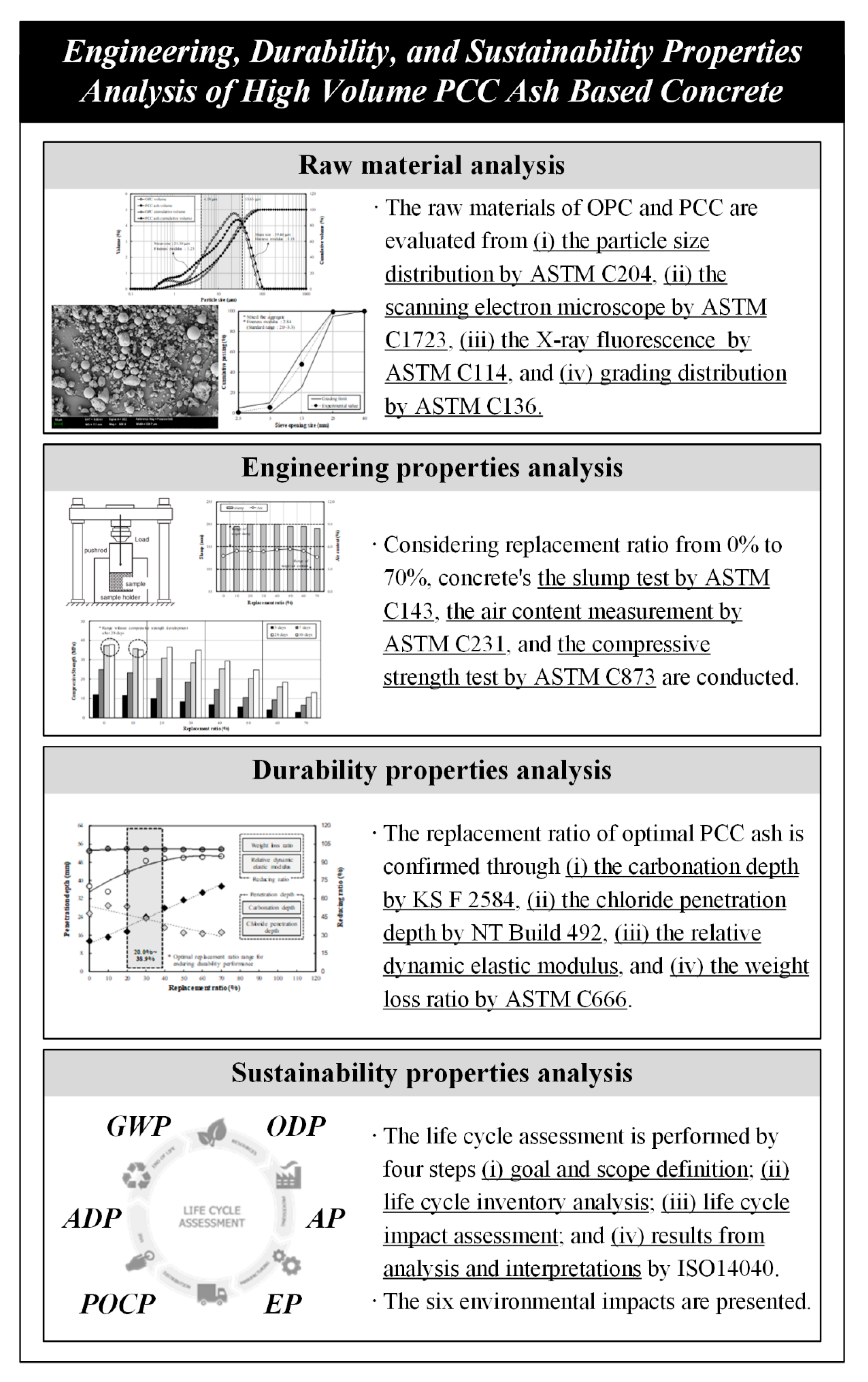
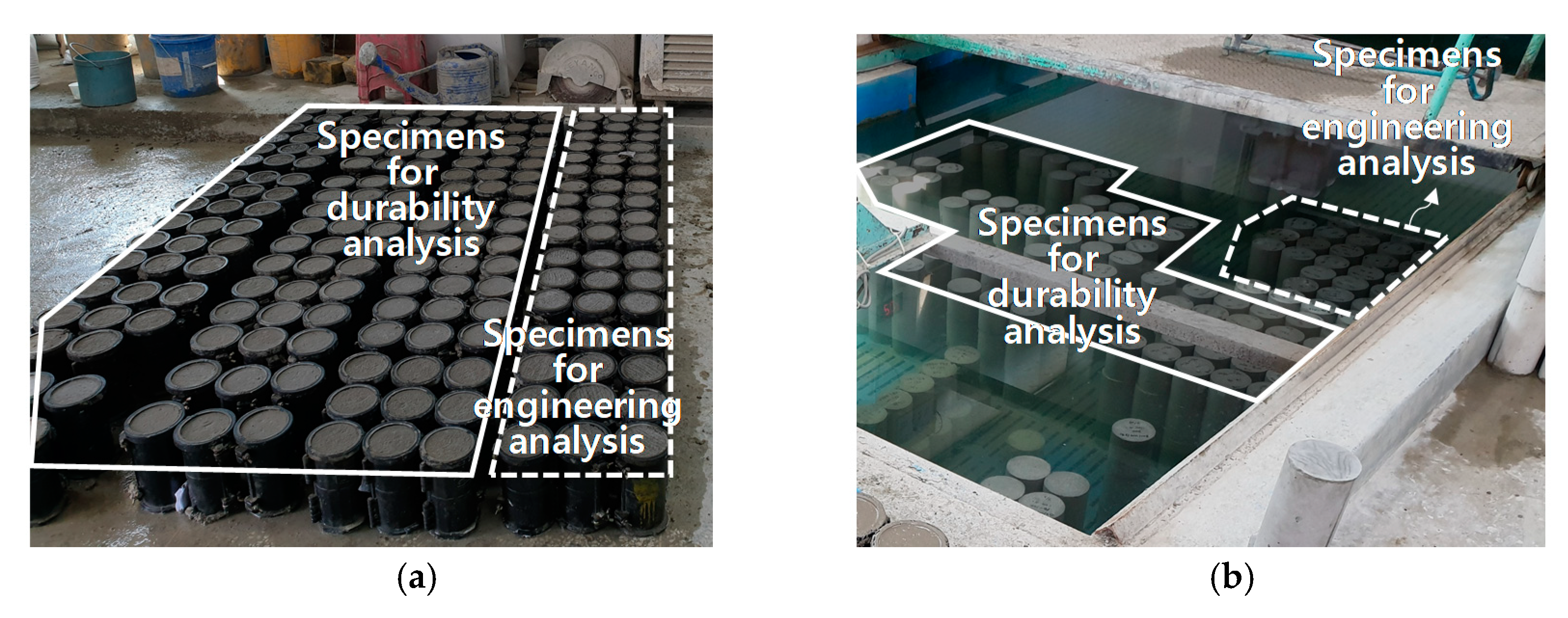
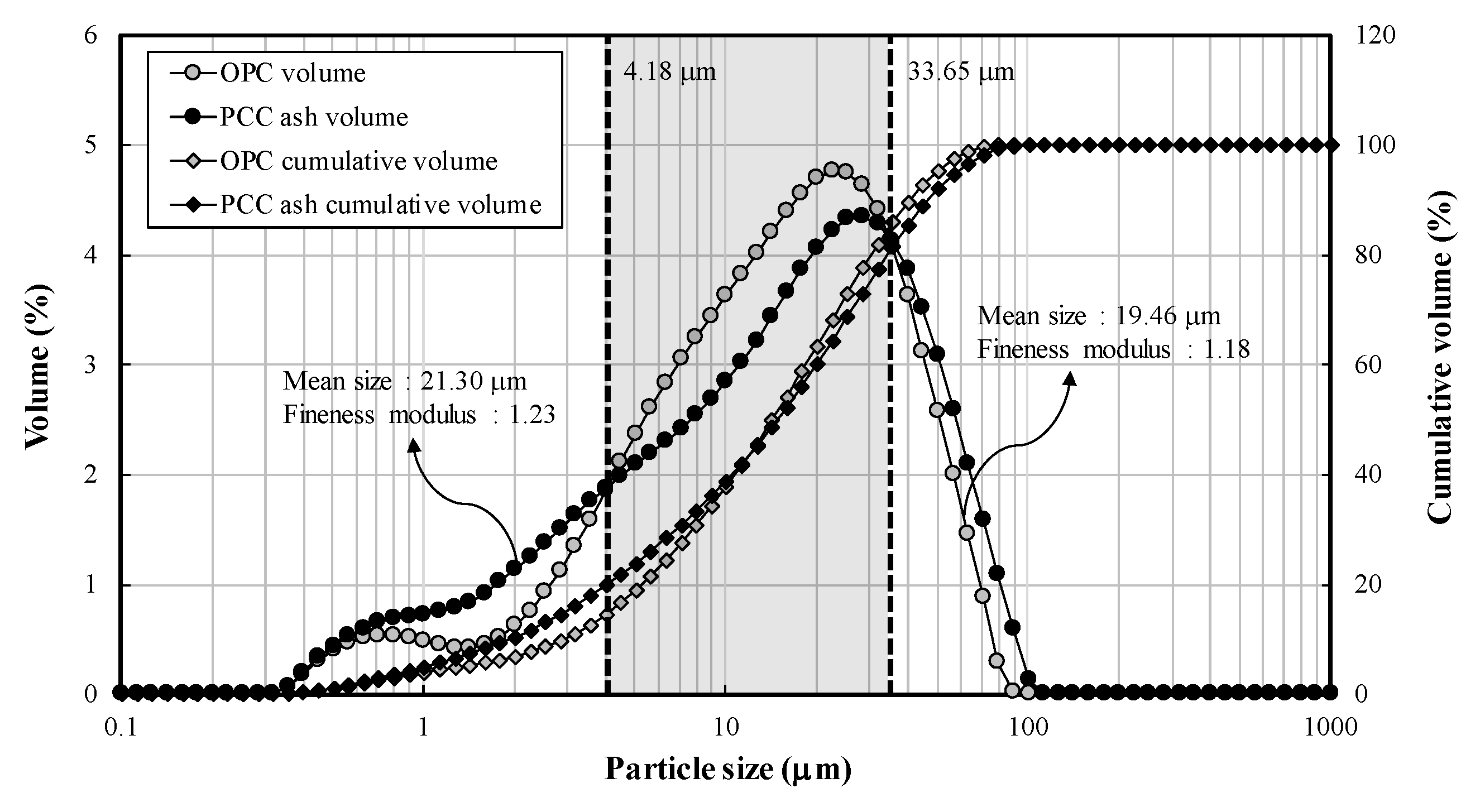

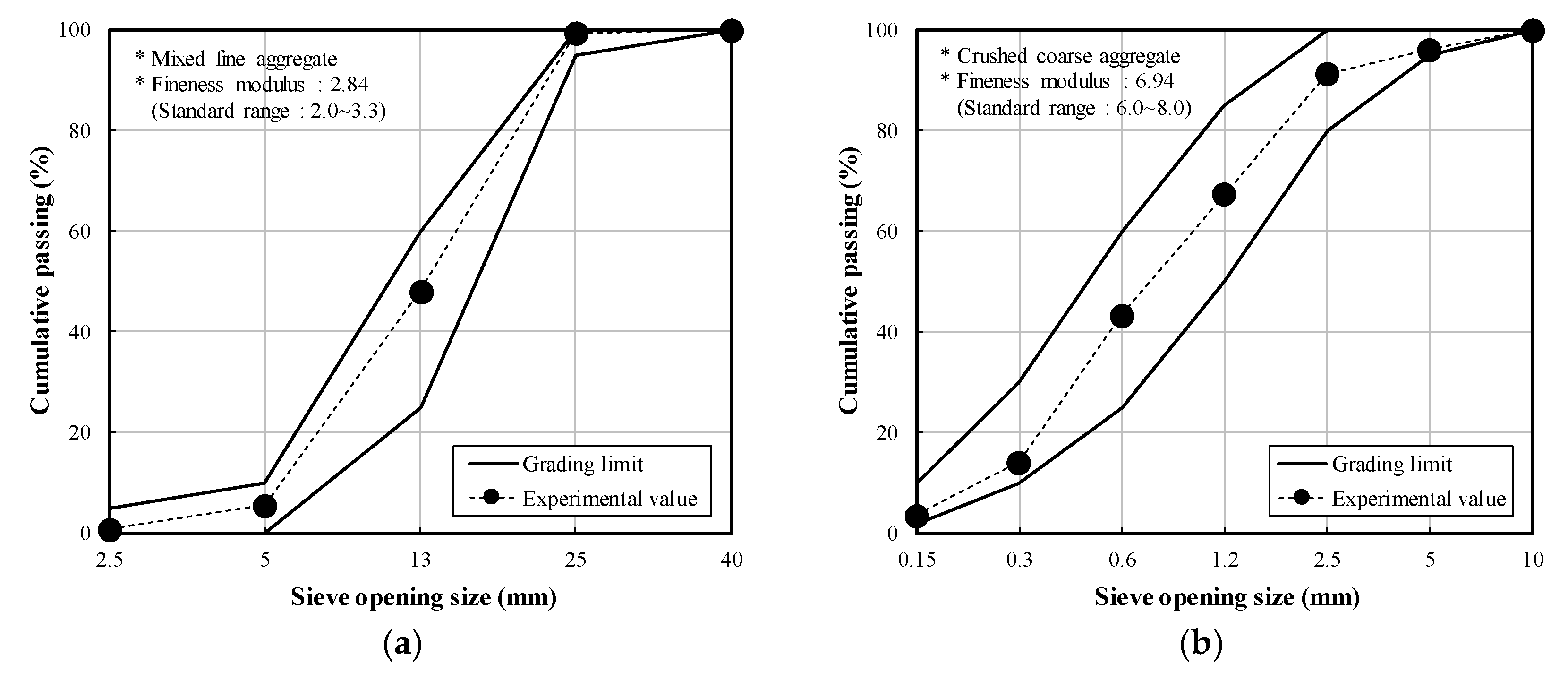
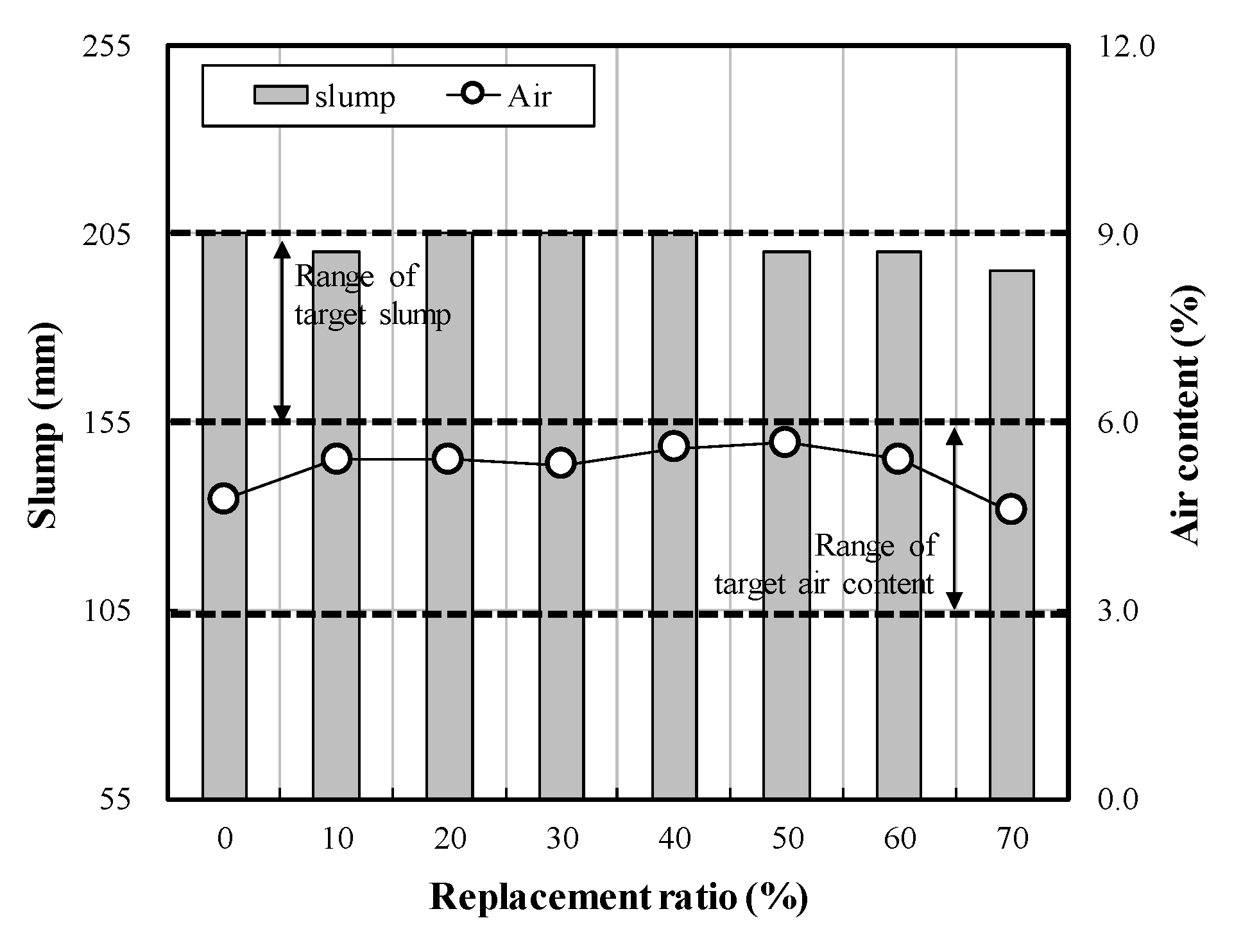
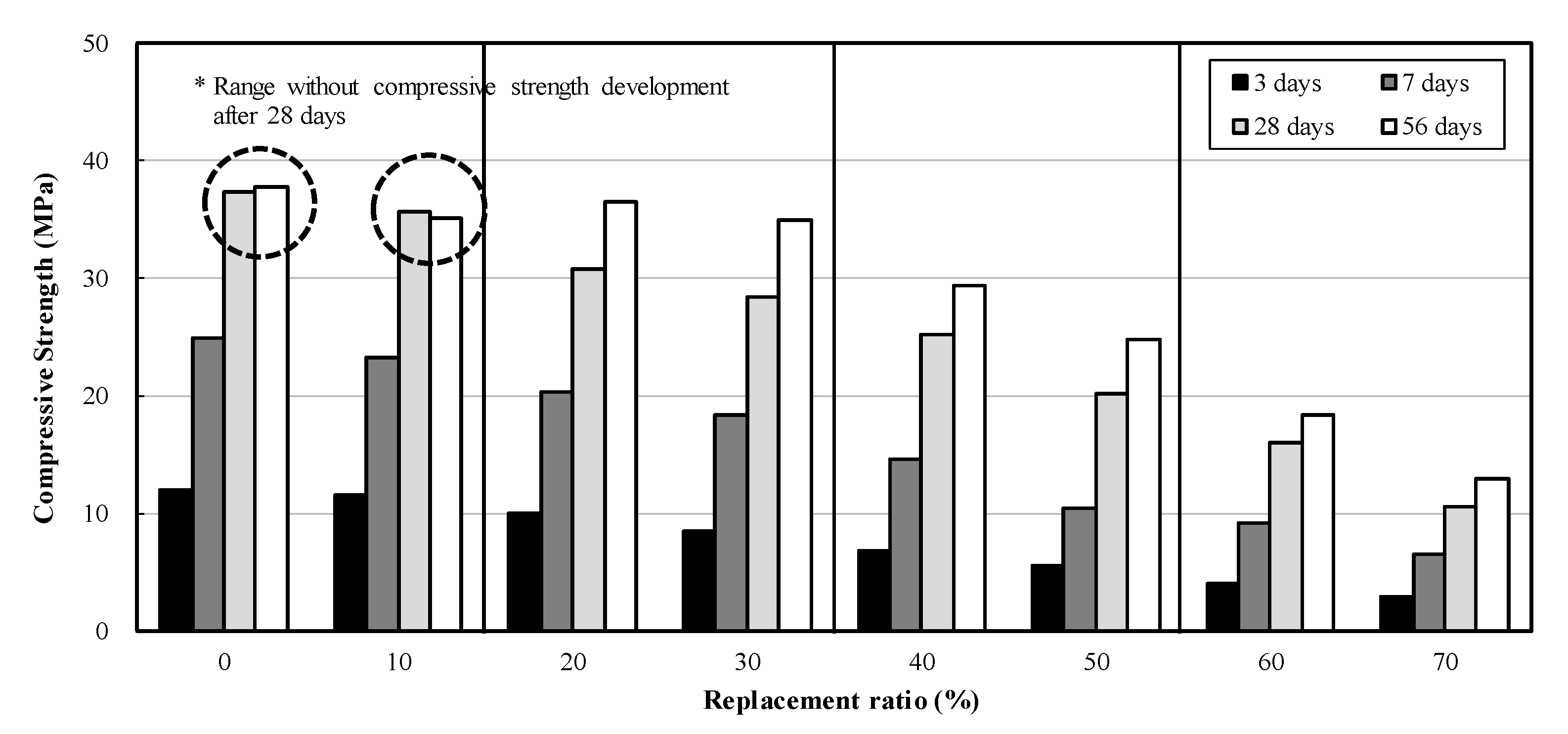
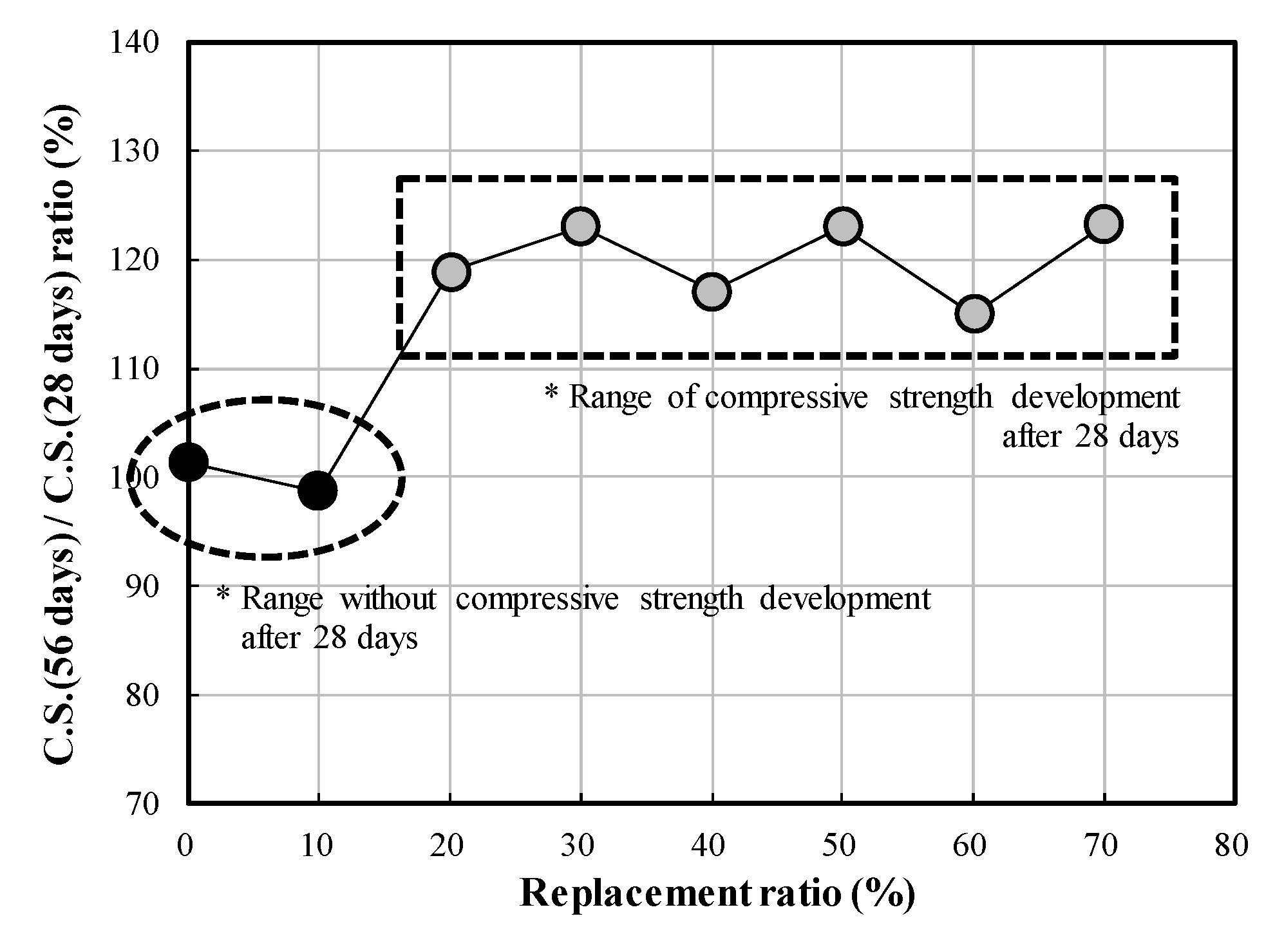

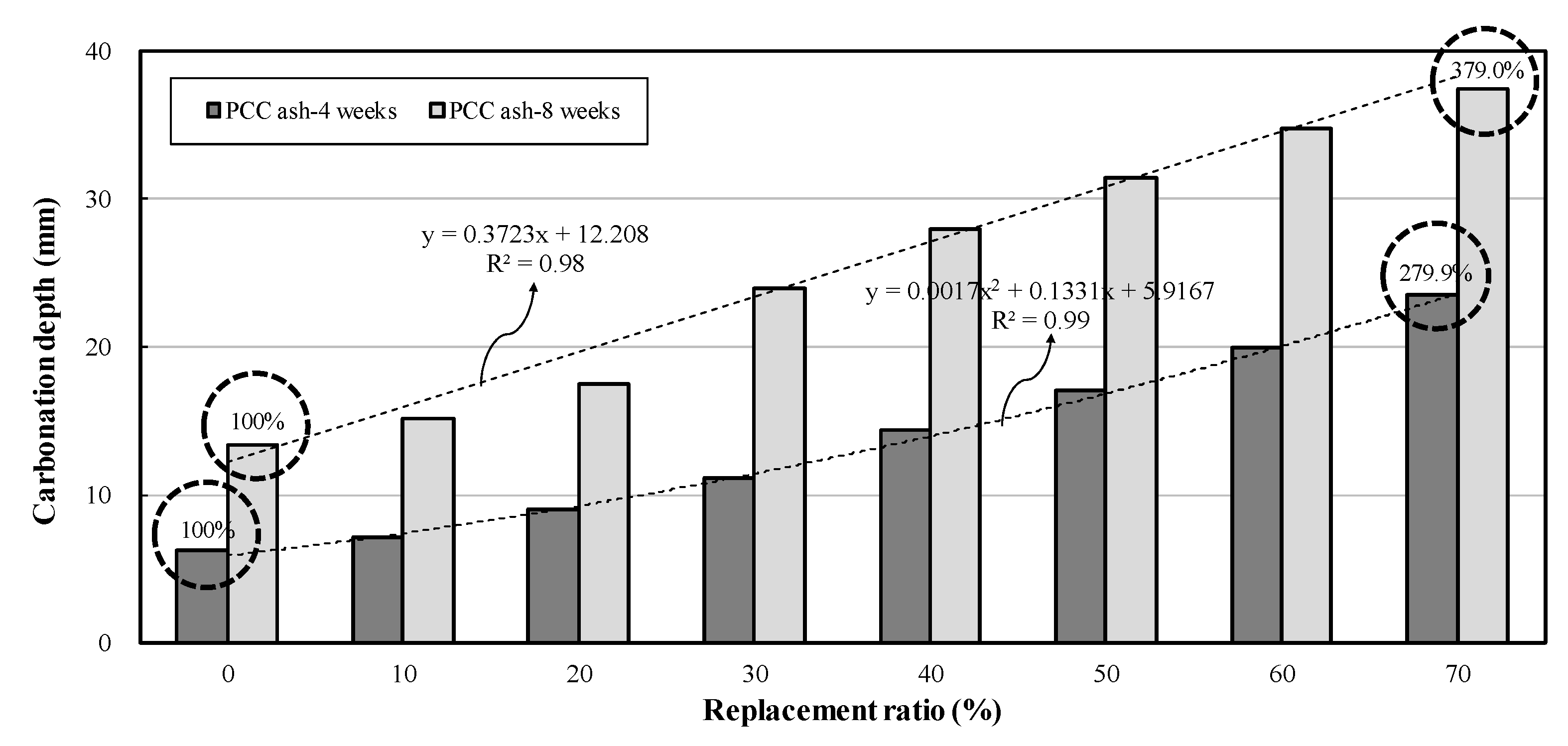
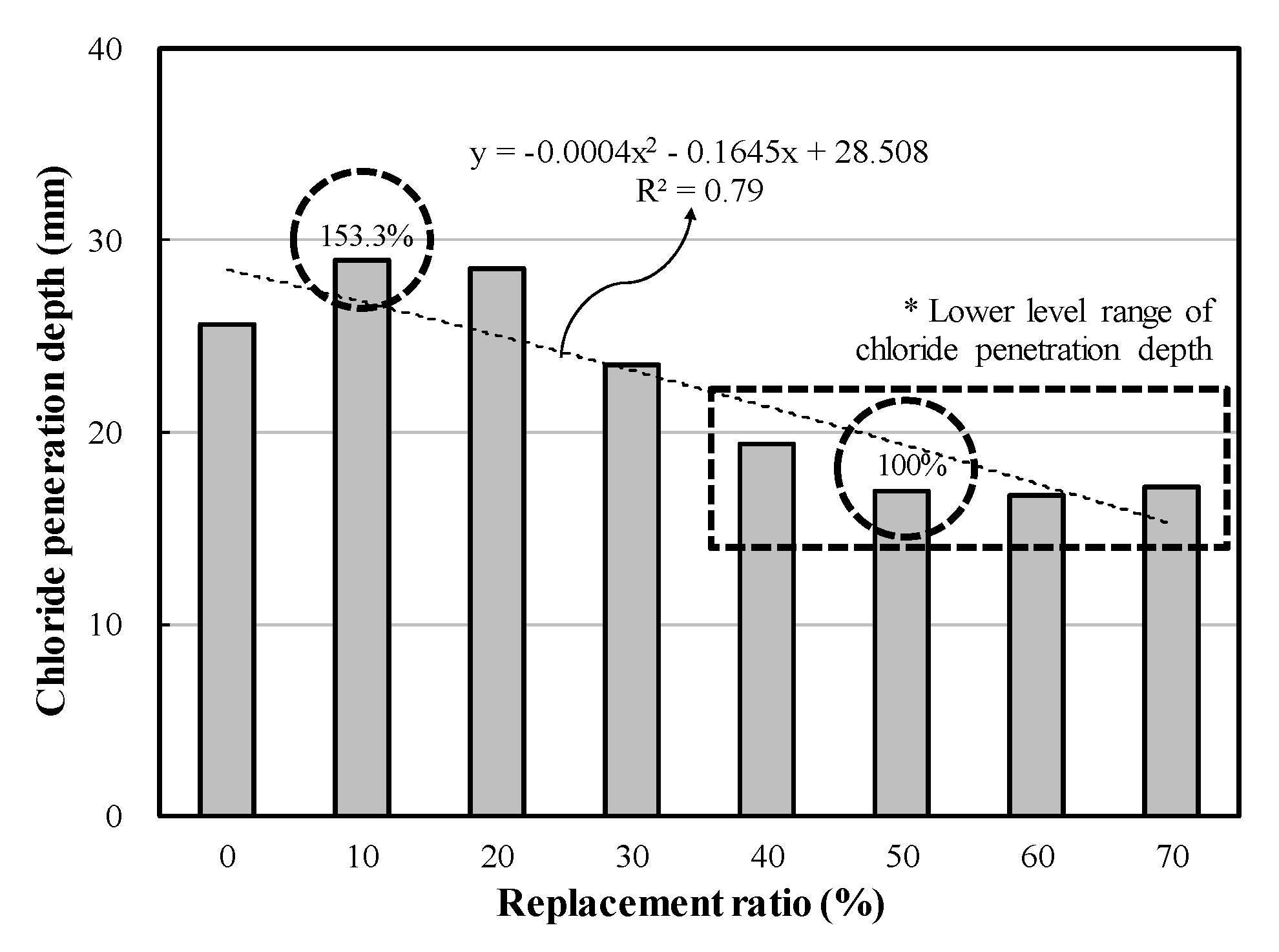
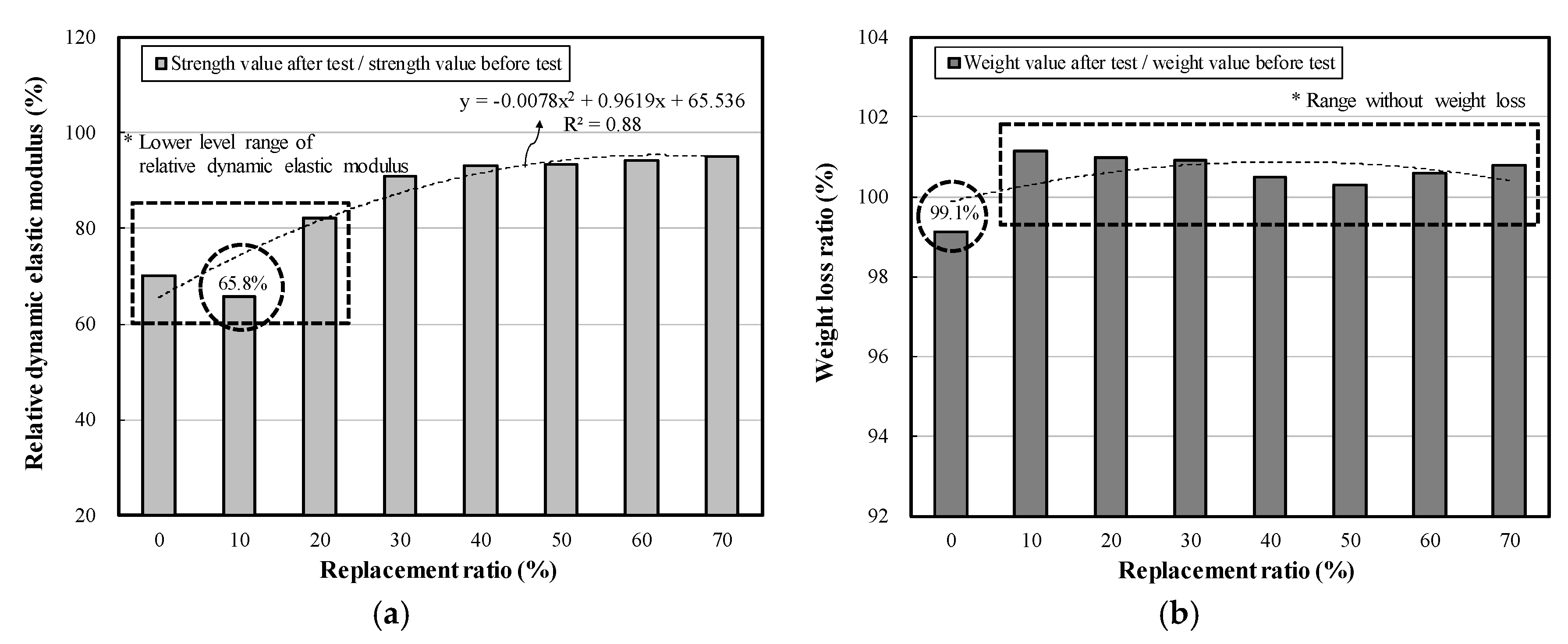



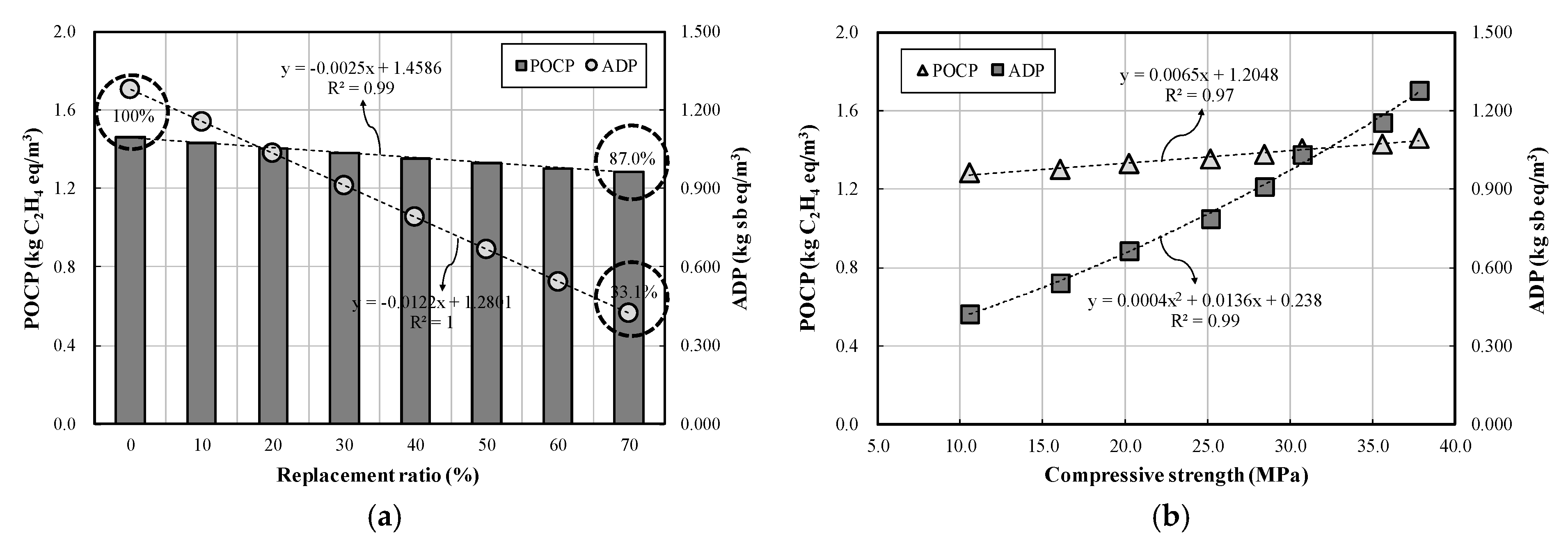
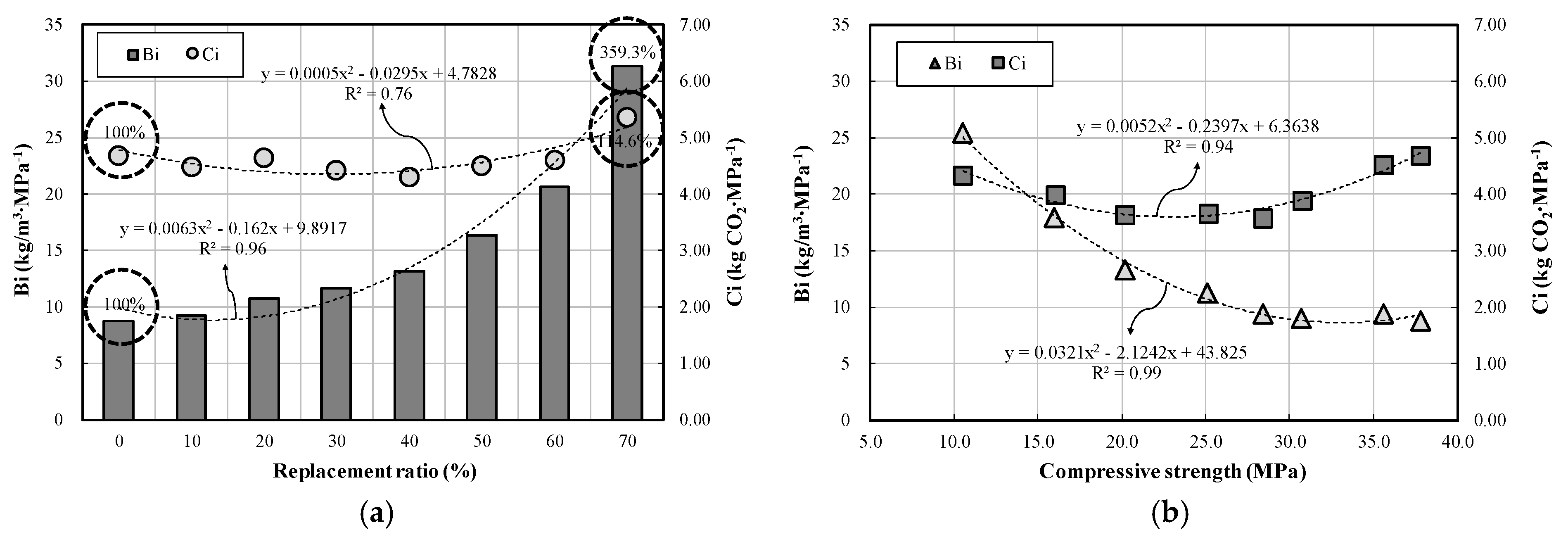
| Material | Chemical Composition (%) | ||||||||
|---|---|---|---|---|---|---|---|---|---|
| CaO | SiO2 | Al2O3 | Fe2O3 | MgO | K2O | Na2O | SO3 | Other | |
| OPC 1 | 60.20 | 21.60 | 5.15 | 3.30 | 2.30 | 0.99 | 0.53 | 1.50 | 4.43 |
| PCC ash 2 | 4.00 | 57.90 | 20.50 | 6.80 | 1.38 | 1.18 | 0.89 | - | 7.35 |
| Material | Property | |
|---|---|---|
| OPC | Type 1 ordinary Portland cement (KS L 5201) Density: 3.15 g/cm3, specific surface area: 3322 cm2/g | |
| PCC ash | Type 2 pulverized coal combustion ash (KS L 5405) Density: 2.14 g/cm3, specific surface area: 3964 cm2/g | |
| Fine aggregate | S1 | Washed sea sand Fineness modulus: 2.01, density: 2.60 g/cm3, absorption: 0.79% |
| S1 | Crushed sand Fineness modulus: 3.29, density: 2.57 g/cm3, absorption: 0.87% | |
| Coarse aggregate | Crushed granitic aggregate Size: 25 mm, density: 2.60 g/cm3, absorption: 0.76% | |
| Chemical admixture | Polycarboxylic acid group, density: 1.05 g/cm3 | |
| Mix No. | Unit Weight (kg/m3) | ||||
|---|---|---|---|---|---|
| W/B | Water | Binder | OPC | PCC Ash | |
| Plain | 0.53 | 175 | 330 | 330 | 0 |
| P1 | 297 | 33 | |||
| P2 | 264 | 66 | |||
| P3 | 231 | 99 | |||
| P4 | 198 | 132 | |||
| P5 | 165 | 165 | |||
| P6 | 132 | 198 | |||
| P7 | 99 | 231 | |||
| Series | Evaluation Item | Test Method |
|---|---|---|
| I. Raw material analysis | Particle size distribution (%) | ASTM C204 |
| Scanning electron microscope | ASTM C1723 | |
| X-ray fluorescence | ASTM C114 | |
| Grading distribution (%) | ASTM C136 | |
| II. Engineering properties analysis | Slump (mm) | ASTM C143 |
| Air content (%) | ASTM C231 | |
| Compressive strength (MPa) | ASTM C873 | |
| ASTM C39 | ||
| III. Durability properties analysis | Carbonation depth (mm) | KS F 2584 |
| Chloride penetration depth (mm) | NT Build 492 | |
| Relative dynamic elastic modulus (%) | ASTM C666 | |
| Weight loss ratio (%) | ||
| IV. Sustainability properties analysis | Global warming potential (kg CO2 eq/m3) | ISO 14040 |
| Ozone layer depletion potential (CFC-11 eq/m3) | ||
| Acidification potential (kg SO2 eq/m3) | ||
| Eutrophication potential (kg PO43− eq/m3) | ||
| Photochemical ozone creation potential (kg C2H4 eq/m3) | ||
| Abiotic depletion potential (kg Sb eq/m3) |
| Materials | Environmental Impacts | |||||
|---|---|---|---|---|---|---|
| GWP (kg CO2 eq.) | ODP (kg CFC-11 eq.) | AP (kg SO2 eq.) | EP (kg PO43-eq.) | POCP (kg C2H4 eq.) | ADP (kg Sb eq.) | |
| OPC | 5.32 × 10−1 | 1.27 × 10−9 | 3.68 × 10−4 | 6.60 × 10−5 | 1.15 × 10−4 | 3.76 × 10−3 |
| PCC ash | 1.01 × 10−2 | 2.99 × 10−9 | 4.97 × 10−5 | 7.28 × 10−6 | 1.91 × 10−5 | 6.82 × 10−5 |
| Water | 8.88 × 10−3 | 9.32 × 10−7 | 2.53 × 10−2 | 7.06 × 10−4 | 7.39 × 10−3 | 2.07 × 10−4 |
| Environmental Impact Factor | Degree of Environmental Impact Reduction | |
|---|---|---|
| 20.0% | 38.9% | |
| GWP | 34.52 kg CO2 eq/m3 | 67.15 kg CO2 eq/m3 |
| ODP | 6.0 × 10−6 kg CFC-11 eq/m3 | 11.7 × 10−6 kg CFC-11 eq/m3 |
| AP | 0.17 kg SO2 eq/m3 | 0.33 kg SO2 eq/m3 |
| EP | 0.01 kg PO43− eq/m3 | 0.02 kg PO43− eq/m3 |
| POCP | 0.05 kg C2H4 eq/m3 | 0.10 kg C2H4 eq/m3 |
| ADP | 0.24 kg Sb eq/m3 | 0.47 kg Sb eq/m3 |
© 2020 by the authors. Licensee MDPI, Basel, Switzerland. This article is an open access article distributed under the terms and conditions of the Creative Commons Attribution (CC BY) license (http://creativecommons.org/licenses/by/4.0/).
Share and Cite
Lee, J.; Lee, T.; Jeong, J.; Jeong, J. Engineering, Durability, and Sustainability Properties Analysis of High-Volume, PCC Ash-Based Concrete. Sustainability 2020, 12, 3520. https://doi.org/10.3390/su12093520
Lee J, Lee T, Jeong J, Jeong J. Engineering, Durability, and Sustainability Properties Analysis of High-Volume, PCC Ash-Based Concrete. Sustainability. 2020; 12(9):3520. https://doi.org/10.3390/su12093520
Chicago/Turabian StyleLee, Jaehyun, Taegyu Lee, Jaewook Jeong, and Jaemin Jeong. 2020. "Engineering, Durability, and Sustainability Properties Analysis of High-Volume, PCC Ash-Based Concrete" Sustainability 12, no. 9: 3520. https://doi.org/10.3390/su12093520
APA StyleLee, J., Lee, T., Jeong, J., & Jeong, J. (2020). Engineering, Durability, and Sustainability Properties Analysis of High-Volume, PCC Ash-Based Concrete. Sustainability, 12(9), 3520. https://doi.org/10.3390/su12093520








